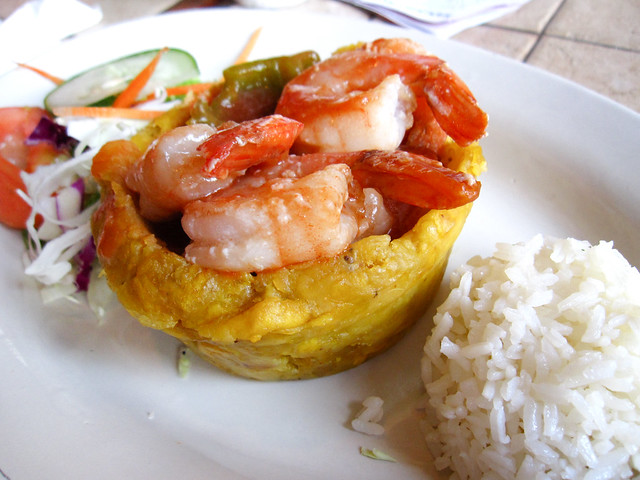Image:
“Mofongo
en el Pilón”
by Yolanda Rodriguez,
to view and buy her artwork, visit her Artist's
Page at
A
few weeks ago, I wrote about plantains
and shared ways to shop, prepare and cook them. A very versatile
fruit! I even mentioned the plantain's stain as the metaphysical soul
of the Puerto Rican, the subject of poetry no less.
We
were discussing comfort foods (there was mention of chocolate,
cheese, mashed potatoes, and bacon – of course). To Puerto Ricans,
whether island-bound, in the mainland or spread across the globe, the
mere mention of mofongo is cause for sighs, salivating, and
all sorts of warm fuzzies. Dominicans have a similar dish they call
mangú
and Cubans have a boiled version they call fufu.
Along
with asopao (soupy rice), arroz con gandules (rice with
pigeon peas), and lechón asado (roast pork), mofongo
is one of the island's national dishes.
Clearly
influenced by its African ancestry, mofongo is a dish composed
of fried green plantains. Traditionally, the fried slices are salted,
placed in a pilón (a marinaded, wooden mortar) and mashed
down.
Some
add butter at this stage, I prefer a good virgin olive oil, and
garlic. The mofongo is then served with a garlic sauce and
generally “stuffed” with chicharrón (crackling) or roast
pork (new fusion versions also include shrimp, lobster, and other
fried meats, as well as vegetables).
Then,
there are several ways to top it, from the aforementioned ajilimójili
(garlic sauce) – from broth, pureed
seafood, and even spicy black beans.
There
is a whole new entity that has entered the arena: trifongo.
This culinary sexy beast includes green plantains, ripe plantains,
and yucca (cassava).
Trifongo
2
green plantains
1
ripe plantain (yellow)
1
small yucca
oil
for browning
salt
Pick
yellow, not blackened, ripe plantains or the dish will come out
really sweet (dessert sweet).
Peel
yucca and cut in quarters. Parboil 5-10 minutes depending on
quantity. You want it softened and you can remove the fibrous
filaments in the center. (You can do this step ahead of time and
refrigerate the yucca.)
You'll
take the skin off as instructed earlier, slice and set aside. Some
people place the plantain slices in cold, salted water until ready to
start (dry before placing in frying pan).
Heat
oil, I use enough to cover the bottom of a cast iron pan up to about
1/8th
of an inch (about a quarter cup). Place plantain slices and brown
(this takes no more than 3 or 4 minutes per side). Ripe plantains
will cook and caramelize faster. Brown separately so that the green
retain their savory and the ripe ones retain sweet.
Brown
the yucca, also a few minutes each side.
Set
aside the cooked ones on paper towel to absorbed extra oil, salt
immediately. Place in pilón,
mash. Add oil and garlic, or hot sauce, fried meats, to taste. If you do not own a pilón (mortar and pestle), you may use a spoon to smash the plantain and yucca, and a bowl to mix them.
You can serve the monfongo or trifongo in your pilón (that's the traditional way). If
you don't want to deal with peeling or cannot find the fresh
ingredients, Goya has frozen plantains and yucca. It's convenient,
but I cannot vouch for the taste and texture as I have not used these
products.
The
result is crunchy, creamy, filling, slightly sweet, earthy, sexy,
velvety and delicious. If you are not entirely sure you can hack it
in your own kitchen, find a restaurant that serves it so you can see
it, smell it, taste it, and fall in love with it. Then you can try
it. You will not regret it.





No comments:
Post a Comment